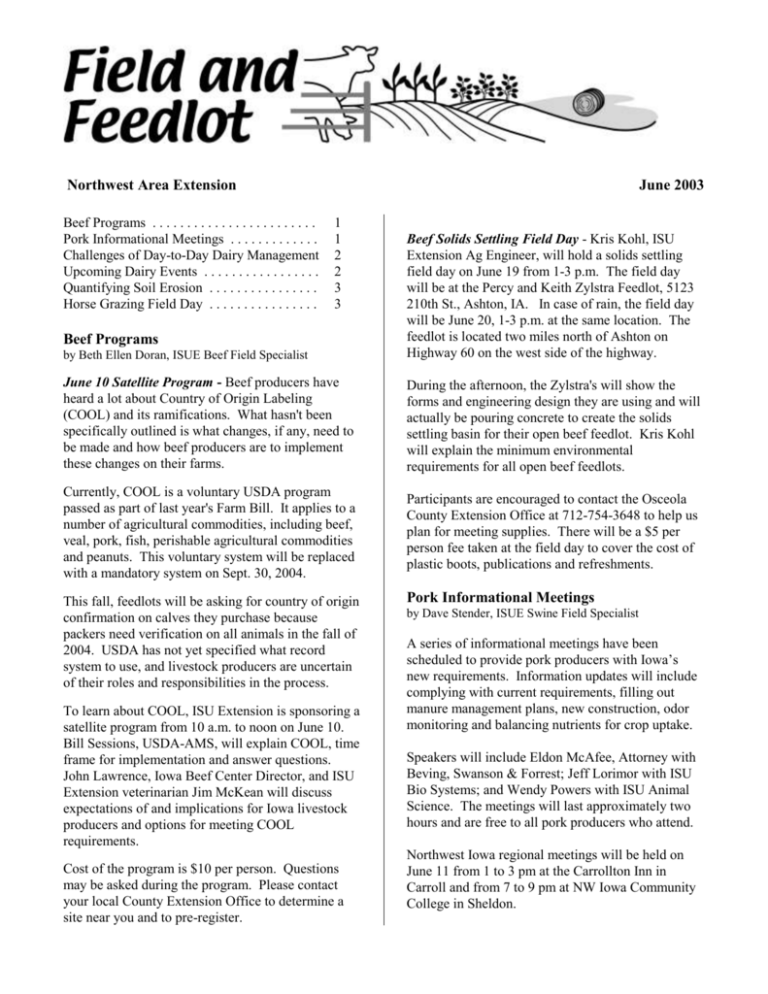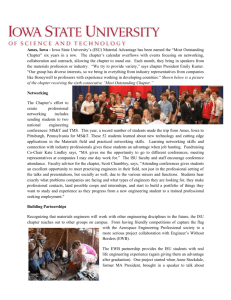Word Document - Iowa State University Extension and Outreach
advertisement

Northwest Area Extension Beef Programs . . . . . . . . . . . . . . . . . . . . . . . . Pork Informational Meetings . . . . . . . . . . . . . Challenges of Day-to-Day Dairy Management Upcoming Dairy Events . . . . . . . . . . . . . . . . . Quantifying Soil Erosion . . . . . . . . . . . . . . . . Horse Grazing Field Day . . . . . . . . . . . . . . . . June 2003 1 1 2 2 3 3 by Beth Ellen Doran, ISUE Beef Field Specialist Beef Solids Settling Field Day - Kris Kohl, ISU Extension Ag Engineer, will hold a solids settling field day on June 19 from 1-3 p.m. The field day will be at the Percy and Keith Zylstra Feedlot, 5123 210th St., Ashton, IA. In case of rain, the field day will be June 20, 1-3 p.m. at the same location. The feedlot is located two miles north of Ashton on Highway 60 on the west side of the highway. June 10 Satellite Program - Beef producers have heard a lot about Country of Origin Labeling (COOL) and its ramifications. What hasn't been specifically outlined is what changes, if any, need to be made and how beef producers are to implement these changes on their farms. During the afternoon, the Zylstra's will show the forms and engineering design they are using and will actually be pouring concrete to create the solids settling basin for their open beef feedlot. Kris Kohl will explain the minimum environmental requirements for all open beef feedlots. Currently, COOL is a voluntary USDA program passed as part of last year's Farm Bill. It applies to a number of agricultural commodities, including beef, veal, pork, fish, perishable agricultural commodities and peanuts. This voluntary system will be replaced with a mandatory system on Sept. 30, 2004. Participants are encouraged to contact the Osceola County Extension Office at 712-754-3648 to help us plan for meeting supplies. There will be a $5 per person fee taken at the field day to cover the cost of plastic boots, publications and refreshments. Beef Programs This fall, feedlots will be asking for country of origin confirmation on calves they purchase because packers need verification on all animals in the fall of 2004. USDA has not yet specified what record system to use, and livestock producers are uncertain of their roles and responsibilities in the process. To learn about COOL, ISU Extension is sponsoring a satellite program from 10 a.m. to noon on June 10. Bill Sessions, USDA-AMS, will explain COOL, time frame for implementation and answer questions. John Lawrence, Iowa Beef Center Director, and ISU Extension veterinarian Jim McKean will discuss expectations of and implications for Iowa livestock producers and options for meeting COOL requirements. Cost of the program is $10 per person. Questions may be asked during the program. Please contact your local County Extension Office to determine a site near you and to pre-register. Pork Informational Meetings by Dave Stender, ISUE Swine Field Specialist A series of informational meetings have been scheduled to provide pork producers with Iowa’s new requirements. Information updates will include complying with current requirements, filling out manure management plans, new construction, odor monitoring and balancing nutrients for crop uptake. Speakers will include Eldon McAfee, Attorney with Beving, Swanson & Forrest; Jeff Lorimor with ISU Bio Systems; and Wendy Powers with ISU Animal Science. The meetings will last approximately two hours and are free to all pork producers who attend. Northwest Iowa regional meetings will be held on June 11 from 1 to 3 pm at the Carrollton Inn in Carroll and from 7 to 9 pm at NW Iowa Community College in Sheldon. Challenges of Day-to-Day Dairy Management-- Whose Monkeys are These Anyway!!?? by Chris Mondak. ISUE Dairy Field Specialist Do you ever have a day at your dairy when you have so much to do and so many “fires to put out” that you feel like you have the weight of a thousand monkeys on your back? This is the scenario that Dr. Jim Bennett, DVM, used to capture the attention of producers, professionals, and ag-business representatives at the Northwest Iowa Dairy Days program, March 5- 7. Defines what people at dairy are working towards; and what they should have as an outcome or product of their work each day. Goals should be specific. For example “having a profitable reproductive program” is not a specific goal. Instead, define the reproductive goals specifically as “Average Days Open< 125”, or “Heat Detection Rate >55%”, or “Pregnancy Rate > 19%”. 4. A dairy should set up a simple system to monitor results and give feedback to the members or workers so they know when goals are/are not being met. Set up a simple monitoring system and post it. For example, if one of the dairy’s goals is a SCC of 200,000, this can be monitored by posting the daily or weekly herd SCC levels. All family members and workers then have immediate feedback about the progress. Monitoring progress towards goals gives useful feedback: if goals aren’t met, owner/managers & employees can reevaluate and change processes. If goals are being met, owners and employees have an opportunity to modify processes for ways to meet the goals better (or cheaper). Allows producers to benchmark against each other and constantly learn. Drawing from his years of experience serving dairy clients and helping them trouble-shoot typical dairy problems, Dr. Bennett proposes that every dairy – whether it has 50 cows or 5000 cows – can benefit from applying basic concepts of organization, goal setting, process description for essential tasks, and simple monitoring-feedback schemes. Here is a summary of his key points: 1. A dairy should have a structure - Make an Organizational Chart and identify responsibilities of everyone on the chart. It defines who is the boss and the role and assignment of all people who work at the dairy- both family and non-family. It establishes the flow of communication. It establishes who has what jobs, and helps prevent one person from becoming overloaded with too many “monkeys” – (tasks). If you would like to obtain a copy of the Dr. Bennett’s presentation and the NW Iowa Dairy Days Proceedings, contact the Sioux County Extension Office, 712-737-4230, or Chris Mondak at cmondak@iastate.edu. 2. A dairy should have a defined set of processes that describe how essential tasks get done. Written processes can be simply stated as flow charts, lists, or diagrams. They are dynamic – can adjust to changing situations. Most problems stem from one of two critical process problems: the wrong process is being used, or the right process is being performed wrong. When essential processes are performed correctly and consistently by all workers or family members, the desired outcomes of quality milk, healthy cows, and happy employees can be achieved. Upcoming Dairy Events June 9, Sioux County Dairywomen’s Peer Group Orange City Pizza Ranch, 11:30 – 1:30pm. June 16, Sioux County Dairy Banquet Sioux Center Community Center, serving 6:15 – 7pm; program starts at 7:30pm. June 23 Sioux County Dairywomen’s Peer Group Sioux Center Pizza Ranch, 7- 8:30pm. June 24 Osceola- O’Brien County area Dairywomen’s Peer Group Tour at Plymouth Dairy, 11:30 – 1:30pm. July 1 3. A dairy should have a set of goals in general, and goals for each worker or team. 2 Quality Milk & Mastitis Control Workshop- Updates on Methods and Products. Two locations and times: Boyden- Demco Community Center, Noon- 3pm Cherokee County Extension office, 7pm – 10pm. hard look at soil conservation programs and consider making a change. Quantifying Soil Erosion By Todd Vagts, ISUE Field Crops Specialist Here are some simple and easy to implement conservation practices: Plant corn directly into soybean stubble Plant soybeans using no-till – or high residue methods Contour plow and plant Maintain waterways Install and maintain filter strips where water drains from fields. A short drive though the countryside reveals once again the problem northwest IA has with soil erosion. I thought in late April the area might be spared the heavy and continuous rains that cause excessive erosion on hillsides, but as May rain kept falling, soils became saturated and excess water moved downhill, taking soil with it. Often, erosion events appear small and insignificant, but when they happen one or more times per year for successive years, serious and long-term damage is inflicted on the soil and water resources. Research in Iowa has shown that long-term erosion that reduces the thickness of the A soil horizon (top layer) reduces corn grain yield potential. Visit this ISU Web Site http://extension.agron.iastate.edu/soilmgmt for an interactive analysis of your current conservation practices. Soil is lost through three major erosive actions: sheet, rill and gully erosion. I think the predominant and probably most overlooked erosion is Rill erosion; which is characterized by small “rills” that are less visible and easily removed with tillage. Once the visible signs of rill erosion are covered up, the short and long-term consequence is soon forgotten. But let’s take a moment to characterize just how much soil is being lost by rill erosion. A quick mathematical equation can be employed to quantify the destructive nature of rill erosion. Horse Grazing Field Day by Beth Ellen Doran, ISUE Beef Field Specialist Horse owners are invited to a twilight grazing field day on June 17 from 7-9:30 p.m. at the ISU Demonstration and Research Farm, near Calumet. The farm is located one mile south of Calumet on Highway 59 and 1/4 mile east on County Road B-62. Dr. Steve Barnhart, ISU Extension Forage Agronomist, will take participants on tour of small forage plots at the farm. Steve will discuss the characteristics of various forage plants, including ease of establishment, suitability for grazing and haying, hardiness and anti-quality factors. He will also explain which forages are more suitable for various drainage conditions. Tons of soil lost = (A*B*C*D)/2000 Where A = Average width; B = Depth; C = Length; D = Soil Unit Wt. (85 lb/ft3) Using the above equation in a simple example yields the following soil loss. An 80-acre field (1320 ft x 2640 ft) with one long-sloping hillside with crop rows that run up the hill. After one heavy spring rainfall just after planting, water runs down each row marker, creating an (average) 2-inch wide by 2-inch deep rill. Although the size of each rill seems small and insignificant, the total soil lost in each row marker would be 76 ft3 or 3.2 tons. Total soil lost from the 80-acre field (43 marks) would be 3,281 ft3 or 139 tons. The simple solution to this problem would be to plant along the contour of the hill. Dr. Peggy Miller, ISU Extension Horse Specialist, will discuss various grazing systems (continuous, rotational and highly intensive) and emphasize stocking rates, fencing and grazing precautions. She will also explain the role of forages in the horse diet, balancing rations that include forages, and evaluating hays for horses. Pre-registration ($10/person) is required by June 13 at the Lyon County Extension Office. Checks should be made payable to Lyon County Extension and mailed to Lyon County Extension, P.O. Box 348, Rock Rapids IA 51246. Please indicate the names and number of people attending. As responsible farmers and agronomists, it is important to ask, “Can we do a better job of keeping the soil from eroding?” Maybe it’s time to take a 3 JUNE 2003 FIELD AND FEEDLOT Iowa State University Extension Connection By Al Grigg, County Extension Director Livestock producers are invited to attend this free meeting and no registration is necessary. THANK YOU to all who have responded with your e-mail address so we can send you the Field and Feedlot publication electronically. BEEF SOLIDS SETTLING FIELD DAY A beef solids settling field day will be held at the Percy and Keith Zylstra Feedlot located north of Ashton on Thursday, June 19 from 1-3 pm. Kris Kohl, Iowa State University Ag Engineer, will explain the minimum environmental requirements for all open beef feedlots and will show the forms and engineering design to create a solid settling basin for the Zylstra feedlot. Call the Osceola County Extension office at 712-754-3648 if you plan to attend so meeting supplies can be arranged. Cost of the field day is $5 per person. COOL SATELLITE PROGRAM JUNE 10 The Country of Origin Labeling (COOL) program included in the 2002 Farm Bill will require retailers to notify their customers of the country of origin of several commodities, including pork, beef, and lamb, effective September 30, 2004. Although the language applies specifically to retailers, producers also will have a role in making sure the retailer has correct and appropriate information. RESEARCH FARM FIELD DAY The annual field day for the NW Iowa Experimental Farm located south of Calumet will be Wednesday, June 25 starting at 9:30 am. Four speakers will be featured on the farm tour. ISU Extension Soybean Specialist Palle Pedersen will discuss soybean management issues for 2003. Mark Westgate, ISU Associate Professor of Agronomy, will discuss pollen drift. Dr. Jon Tollefsen, ISU Entomologist, will present information on corn rootworm research and management. Dr. Robert Hartzler, ISU Extension Weed Specialist, will discuss weed management issues including herbicide resistance. Livestock producers are invited to attend a satellite program hosted by Iowa State University Extension in partnership with the Iowa Pork Industry Center and the Iowa Beef Center on Tuesday, June 10, from 10 am to noon at county extension offices. Speakers will be William Sessions of USDA Ag Marketing Service, and John Lawrence and James McKean of Iowa State University Extension, presenting information on the COOL program, including expectations of and implications for Iowa livestock producers, dates for mandatory participation in COOL and options for meeting COOL-related requirements. Audience members can ask questions by phone, fax and e-mail during the program. Cost to attend is $10 per person. Please call the Osceola County extension office at 712-754-3648 to reserve a seat. LIVESTOCK REGULATION MEETING A meeting on Wednesday, June 11 at NW Iowa Community College in Sheldon beginning at 7 pm will provide the latest information on new Iowa regulations for livestock production. Eldon McAfee, attorney, and Wendy Powers, Jeff Lorimor and Kris Kohl of Iowa State University Extension will present information on current environmental regulation compliance, manure management plan development and new construction requirements, odor monitoring and learning to balance nutrients for optimal crop uptake. 4






